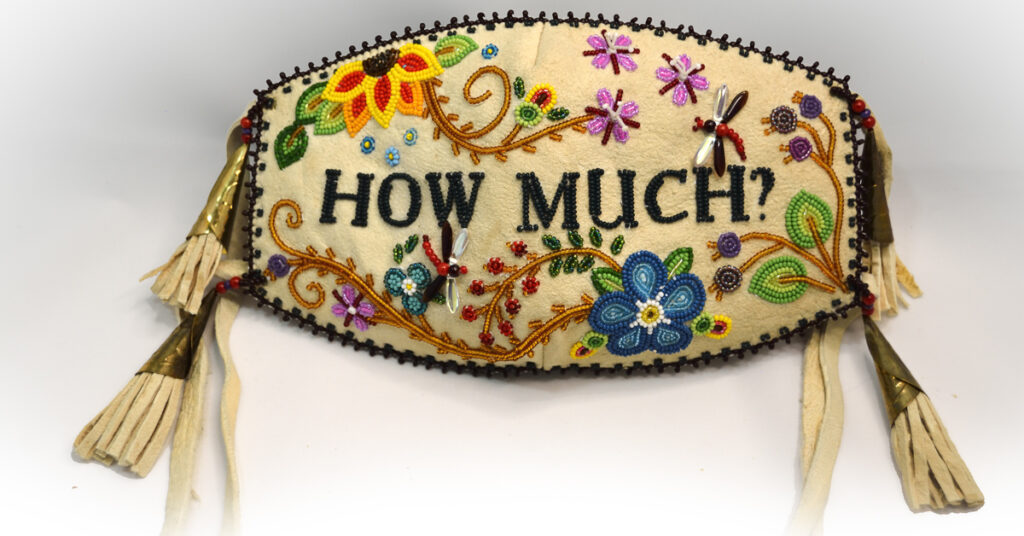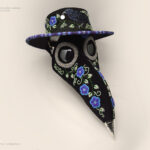
Lisa Shepherd, How Much?, Brain-tanned buckskin, glass beads, tin jingles, cotton fabric, 25cm x 21cm x 6cm
The eighth Reinventing the Wheel talk focuses on the craft of protection, as featured in the latest issue of The Journal of Modern Craft.
Social media was filled with people wearing their own handmade masks, often in showy patterns, images that bespeak anxiety and pride in equal measure. This was just one way that a nation on lockdown began turning to craft, as if by ancient instinct.
Glenn Adamson, Craft: An American History, Bloomsbury, 2021.
The next event in Reinventing the Wheel expanded on the Art of Masks series that appears in the current issue of The Journal of Modern Craft (14.1, April 2021). In 2020, curator Caroline Kipp organised a series of conversations to reflect on the way that scientists, historians, artists, designers and craftspeople engaged with the making and wearing of masks during the pandemic. This raised issues of the materiality of sanitisation, adornment at a time of social distancing, and how the mask has become a canvas for political, social and cultural identity. We hear from contributors and others who have reflected on the creative value of mask-making and its histories. This is the inaugural collaborative event between The Journal of Modern Craft and Garland/Reinventing the Wheel, that we aim to run three times a year, coinciding with the publication of each issue of The Journal of Modern Craft.
It’s difficult to summarise such a rich and intensive series of presentations. It is worth watching the video carefully for this. But there did seem to be a general point that emerged. This discussion framed the art and craft responses to mask production during the pandemic in broader historical and political contexts. One key issue was the value of masks beyond that of protection. There were examples of older masks that had sacred meaning and marked social class. During the pandemic, however, masks were more often worn as expressions of solidarity. Thus they became prominent vehicles for messaging about causes, particularly related to social justice.
There were also ways in which it offered a new canvas for existing crafts, particularly textile techniques such as beading. While this is happening there is tension with the forces that seek to separate individuals, including industrial sanitation regimes and the introduction of elite brands. There is potential to think that the mask-making response to the pandemic has forged a new forum for craft as the redoubt for the social, which will become only more necessary with the evolution of algorithms, automation and surveillance.
Speakers
Caroline Kipp, whose series of talks inspired the issue of JMC, is Curator of Contemporary Art at The George Washington University Museum and The Textile Museum
Alison Matthews David is the Graduate Program Director for Ryerson University’s MA Fashion program. She is the author of Fashion Victims: The Dangers of Dress Past and Present (Bloomsbury), and Killer Style: How Fashion Has Injured, Maimed and Murdered Through History (Owlkids).
Kate Kretz is a visual artist, trained as a painter. She holds a BFA from State University of New York at Binghamton, and an MFA from the University of Georgia.
Maegen Black is the Director of the Canadian Crafts Federation and North American President for the World Crafts Council.
Anna Battista publishes one of the most prodigious craft platforms around, Irenebrination, looking at the world through a textile and fashion lens.
Professor Andrew Groves is the founder and director of the Westminster Menswear Archive, whose curator is Danielle Specher.
See also…



Comments
interesting topic, especially at this point in our pandemic! I participated in Mobilia Gallery’s Ornamentation in the Age of Corona show last year; it was quite wonderful to create masks that were beyond utilitarian (which I made plenty of!) and try to elevate them to a thing of beauty and charm. https://www.mobilia-gallery.com/exhibits/ornamentation-in-the-age-of-corona-masks/